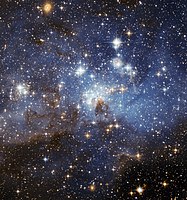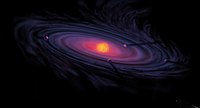
Efficiency of thermal relaxation by radiative processes in protoplanetary discs: constraints on hydrodynamic turbulence
Sign Up to like & getrecommendations! Published in 2017 at "Astronomy and Astrophysics"
DOI: 10.1051/0004-6361/201629933
Abstract: Hydrodynamic, non-magnetic instabilities can provide turbulent stress in the regions of protoplanetary discs, where the MRI can not develop. The induced motions influence the grain growth, from which formation of planetesimals begins. Thermal relaxation of… read more here.
Keywords: hydrodynamic turbulence; protoplanetary discs; thermal relaxation; relaxation ... See more keywords

The influence of infall on the properties of protoplanetary discs
Sign Up to like & getrecommendations! Published in 2020 at "Astronomy and Astrophysics"
DOI: 10.1051/0004-6361/202039154
Abstract: Context. The properties of protoplanetary discs determine the conditions for planet formation. In addition, planets can already form during the early stages of infall. Aims. We constrain physical quantities such as the mass, radius, lifetime,… read more here.
Keywords: protoplanetary discs; mass; formation; infall ... See more keywords

Systematic description of wind-driven protoplanetary discs
Sign Up to like & getrecommendations! Published in 2021 at "Astronomy and Astrophysics"
DOI: 10.1051/0004-6361/202040109
Abstract: Aims. Planet forming discs are believed to be very weakly turbulent in the regions outside of 1 AU. For this reason, it is now believed that magnetised winds could be the dominant mechanism driving accretion… read more here.
Keywords: wind; field; protoplanetary discs; accretion ... See more keywords

Evolution of porous dust grains in protoplanetary discs – I. Growing grains
Sign Up to like & getrecommendations! Published in 2020 at "Monthly Notices of the Royal Astronomical Society"
DOI: 10.1093/mnras/staa382
Abstract: One of the main problems in planet formation, hampering the growth of small dust to planetesimals, is the so-called radial-drift barrier. Pebbles of cm to dm sizes are thought to drift radially across protoplanetary discs… read more here.
Keywords: drift; protoplanetary discs; evolution porous; porous dust ... See more keywords

Modelling thermochemical processes in protoplanetary discs I: numerical methods
Sign Up to like & getrecommendations! Published in 2020 at "Monthly Notices of the Royal Astronomical Society"
DOI: 10.1093/mnras/staa971
Abstract: The dispersal phase of planet-forming disks via winds driven by irradiation from the central star and/or magnetic fields in the disk itself is likely to play an important role in the formation and evolution of… read more here.
Keywords: modelling thermochemical; protoplanetary discs; thermochemical processes; numerical methods ... See more keywords

About the modelling of the SED for the inner boundary of protoplanetary discs at the lower stellar mass regime
Sign Up to like & getrecommendations! Published in 2021 at "Monthly Notices of the Royal Astronomical Society"
DOI: 10.1093/mnras/stab1541
Abstract: In order to improve the physical interpretation about innermost dusty regions in protoplanetary discs around brown dwarf (BD), and even very low mass star (VLMS), we present a grid of models taking into account two… read more here.
Keywords: protoplanetary discs; mass; inner disc; discs ... See more keywords

Axisymmetric simulations of the convective overstability in protoplanetary discs
Sign Up to like & getrecommendations! Published in 2021 at "Monthly Notices of the Royal Astronomical Society"
DOI: 10.1093/mnras/stab2311
Abstract: Protoplanetary discs at certain radii exhibit adverse radial entropy gradients that can drive oscillatory convection (‘convective overstability’; COS). The ensuing hydrodynamical activity may reshape the radial thermal structure of the disc while mixing solid material… read more here.
Keywords: simulations convective; protoplanetary discs; convective overstability; axisymmetric simulations ... See more keywords

Planet-driven density waves in protoplanetary discs: Numerical verification of non-linear evolution theory
Sign Up to like & getrecommendations! Published in 2021 at "Monthly Notices of the Royal Astronomical Society"
DOI: 10.1093/mnras/stab2652
Abstract: Gravitational coupling between protoplanetary discs and planets embedded in them leads to the emergence of spiral density waves, which evolve into shocks as they propagate through the disc. We explore the performance of a semi-analytical… read more here.
Keywords: density waves; evolution; protoplanetary discs; planet ... See more keywords

A Simple Time-Dependent Method for Calculating Spirals: Applications to Eccentric Planets in Protoplanetary discs
Sign Up to like & getrecommendations! Published in 2021 at "Monthly Notices of the Royal Astronomical Society"
DOI: 10.1093/mnras/stab3641
Abstract: Spirals in protoplanetary discs have been used to locate the potential planet in discs. Since only the spiral shape from a circularly orbiting perturber is known, most previous works assume that the planet is in… read more here.
Keywords: time; protoplanetary discs; method; eccentric planet ... See more keywords

Exciting spiral arms in protoplanetary discs from flybys
Sign Up to like & getrecommendations! Published in 2023 at "Monthly Notices of the Royal Astronomical Society"
DOI: 10.1093/mnras/stad742
Abstract: Spiral arms are observed in numerous protoplanetary discs. These spiral arms can be excited by companions, either on bound or unbound orbits. We simulate a scenario where an unbound perturber, i.e. a flyby, excites spiral… read more here.
Keywords: time; protoplanetary discs; spiral arms; flyby ... See more keywords

Signatures of broken protoplanetary discs in scattered light and in sub-millimetre observations
Sign Up to like & getrecommendations! Published in 2018 at "Monthly Notices of the Royal Astronomical Society"
DOI: 10.1093/mnras/stx2523
Abstract: Spatially resolved observations of protoplanetary discs are revealing that their inner regions can be warped or broken from the outer disc. A few mechanisms are known to lead to such 3D structures; among them, the… read more here.
Keywords: inner; protoplanetary discs; scattered light; outer ... See more keywords